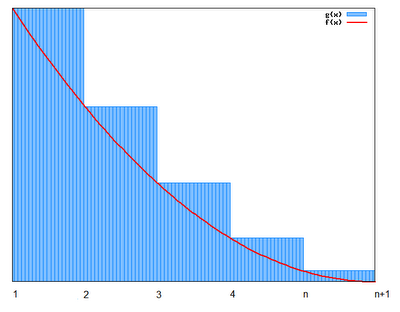The content in today's blog is taken from Harold M. Edwards' Fermat's Last Theorem.
Theorem 1: lim(s ↓ 1) (s-1)ζ(s) = 1
Proof:
(1) From a previous result (see Theorem 4, here), we know that:
ζ(s) = ∑ (1/ns) = ∏ (1 - p-s)-1
and that:
for s greater than 1, both sides of this equation are absolutely convergent (see Theorem 1 and Theorem 2, here).
(2) Using the Integral Test (see Theorem 1, here),
We know that if ∑ (1/ns) converges, then ∫ (1,∞) 1/xsdx also converges.
(3) If we define a function so that f(x) = 1/ceiling(x)s, we can conclude that ∫ (1,∞) 1/xs is less than ∫ (1,∞) 1/ceiling(x)s = ∑ (n=1,∞) 1/ns which is less than 1 + ∫ (1,∞) 1/xsdx since:
(a) ∫ (1,∞) 1/xs is less than ∫ (1,∞) 1/ceiling(x)s
At each point x ≤ ceiling(x) so that at each point xs ≤ ceiling(x)s.

(b) ∫ (1,∞) 1/ceiling(x)s = ∑ (n=1,∞) 1/ns
This follows from the fact that for each interval, ∫ (x,x+1) 1/ceiling(x)s= ∑(n=x,x) 1/ns.
(c) ∑ (n=1,∞) 1/ns is less than 1 + ∫ (1,∞) 1/xsdx
This follows since ∑ (n=1,∞) 1/ns - 1 is less than ∫ (1,∞) 1/xsdx and therefore ∑ (n=1,∞) 1/ns is less than 1 + ∫ (1,∞) 1/xsdx.

(4) ∫ (1,∞) 1/xsdx = 1/(s-1)
(a) ∫ (1,∞) 1/xsdx = lim (t → ∞) ∫ (1,t) 1/tsdt
(b) ∫ 1/tsdt = ∫ t-s dt = 1/(-s+1) (t-s+1) + C = -1/(s-1)(1/ts-1) + C [See here for review of integral if needed]
(c) lim (t → ∞) ∫ (1,t) 1/tsdt = lim(t → ∞) ( [-1/(s-1)][1/ts-1] + [1/(s-1)]*[1/1s-1])=
= lim (t → ∞) [(-1)/[(s-1)*(ts-1)] + [1/(s-1)]*1]
(d) As t → ∞, 1/t → 0 so we get:
= [0*(-1)/(s-1)] + [1/(s-1)] = 1/(s-1)
(5) This gives us that:
1/(s-1) is less than ζ(s) is less than 1 + 1/(s-1)
(6) Multiplying (s-1) to all sides, gives us:
1 is less than (s-1)*ζ(s) is less than (s-1) + 1 = s
(7) Now as s goes to 1, it is clear that we have:
1 ≤ (s-1)*ζ(s) ≤ 1.
(8) Using the Squeeze Law (see Lemma 3, here), we can conclude that the limit is 1.
QED
References
- Harold M. Edwards, Fermat's Last Theorem: A Genetic Introduction, Springer, 2000.
